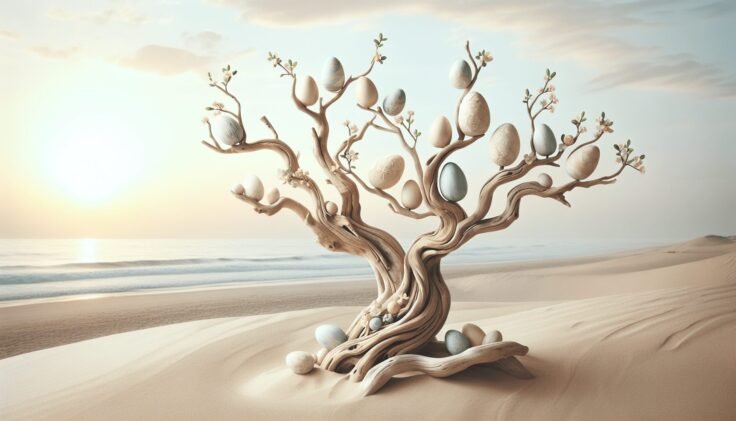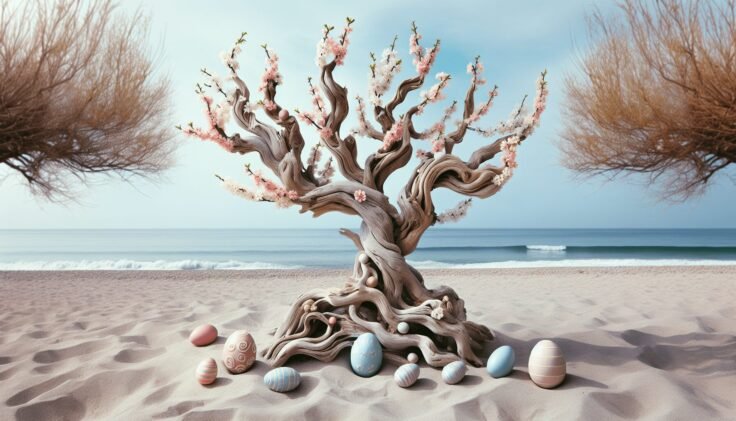Have you ever thought about combining the natural beauty of driftwood with the festive spirit of Easter? Imagine celebrating the joys of spring by crafting a unique and sustainable “Driftwood Easter Tree.” This fascinating and decorative centerpiece can add a touch of coastal charm to your seasonal decor and become a meaningful part of your holiday traditions.
Creating a driftwood Easter tree not only allows you to display creativity but also incorporates natural elements into your home. This guide will delve into what makes a driftwood Easter tree special, how you can create one yourself, and the various ways to personalize and decorate it. With this friendly and thorough step-by-step guide, you’ll be well-equipped to create a masterpiece that reflects both your love for nature and the spirit of Easter.

What is a Driftwood Easter Tree?
A driftwood Easter tree is an ornamental tree made from pieces of driftwood. Driftwood, as you may know, comprises weathered wood pieces found washed up on shores, often collected by those who enjoy the beauty of nature crafted elements. Driftwood is known for its unique shapes, textures, and shades, making it a desirable resource for crafting.
The Appeal of Driftwood
Driftwood’s appeal lies in its natural beauty and versatility. Its rustic appearance can capture the essence of the shore, imbuing any space with a sense of tranquility and connection to nature. Each piece of driftwood is distinct, offering a wide variety of creative opportunities. When used to construct an Easter tree, driftwood provides an organic, eco-friendly alternative to plastic trees or manufactured decor.
Symbolism and Tradition
Easter trees are traditionally known for their symbolic nature, representing new life and the joy of the resurrection. Incorporating driftwood elevates this symbolism by adding a layer of natural renewal and transformation, since driftwood itself represents both decay and rebirth — reminders of nature’s cyclical processes.
Gathering Driftwood
Finding the Right Pieces
To start creating your driftwood Easter tree, the first task is to find the right pieces of driftwood. Consider planning a beach trip where you can collect naturally smoothed and weathered driftwood. Look for pieces that vary in size and shape, as diversity will add character to your tree.
Best Practices for Collection
While collecting, ensure you are mindful of local regulations that may dictate how much driftwood you can take from certain areas. Choose pieces that are relatively dry and free from sharp edges. These characteristics will make it easier to handle and work with the driftwood later in your project.
Cleaning and Preparing Driftwood
Once you’ve gathered your driftwood, it’s important to clean and prepare it. Rinse each piece thoroughly with fresh water to remove salt and sand. You might also choose to scrub the driftwood with a brush to further clean any residue. Allow the wood to dry completely in a sunlit area, which can take a couple of days, depending on humidity levels.
Tools and Materials Needed
To create your driftwood Easter tree, you’ll need some basic tools and materials. Here’s a table that provides a quick overview:
| Tool/Material | Purpose |
|---|---|
| Drill | For making holes in driftwood for assembly |
| Screws | To secure driftwood pieces together |
| Strong adhesive | To add additional stability between joints |
| Twine or wire | To connect smaller driftwood sticks |
| Base or stand | To secure the tree upright |
| Sandpaper | To smooth any rough edges on driftwood |
| Paint (optional) | To add color accents or designs to the tree |
Assembling Your Driftwood Easter Tree
Once you have your materials, you can move on to assembling your driftwood Easter tree. Consider sketching a simple plan or structure vision to help guide your assembly process.
Base Construction
Start by creating or selecting a base. This base could be a piece of heavier driftwood laid flat, a wooden block, or another sturdy material. It needs to be stable enough to support the weight of the tree and any hanging decorations.
Attaching the Trunk and Branches
Build your tree starting with a central trunk, a thicker and longer piece of driftwood. Drill holes and use screws to attach additional branches, working from larger to smaller pieces as you move upward. You might need to adjust branch placement to ensure the tree balances well.
Securing and Testing Stability
Before decorating, ensure all pieces are securely connected and test the tree’s stability. If necessary, add support or adjust branch positions to keep everything balanced.
Decorating Your Driftwood Easter Tree
Once your tree’s structure is complete, it’s time for the fun part — decorating! The beauty of the driftwood Easter tree lies in its customizability. Here are some ideas:
Personalizing with Paint
Some might wish to leave the driftwood in its natural state, while others may prefer adding a touch of color. Consider gentle pastel hues for a more traditional Easter look. You can paint entire branches or simply add painted designs, such as dots or stripes, to emphasize natural patterns.
Adding Easter-inspired Ornaments
Hang Easter eggs, small plush animals, or origami birds on the branches. Consider using lightweight materials or small items so as not to overwhelm or topple the tree. Twine, ribbon, or hooks can be used to secure these items.
Incorporating Natural Elements
Bring more of the outdoors in by incorporating flowers, leaves, or small branches from your garden. Fresh flowers can add a vibrant sense of life, but artificial blooms ensure longevity without the need for maintenance.
Lighting Options
String lights intertwined with the branches can create a warm glow, adding to the tree’s beauty both day and night. Choose battery-powered fairy lights to avoid cords becoming intrusive or cumbersome.

Maintaining Your Driftwood Easter Tree
A well-maintained driftwood Easter tree can be reused and enjoyed for years. After Easter, think about storing it in a dry, safe place. Regularly check for any loose sections or screws that may need tightening.
Seasonal Updates
The flexibility of a driftwood tree makes it possible to adapt the decorations seasonally. Consider redecorating it for other holidays, such as Halloween, where you can transform it into a spooky tree with themed ornaments.
Conclusion
The Driftwood Easter Tree is not merely a festive decoration but a personal statement of creativity and environmental awareness. By learning how to craft and decorate your own tree, you reconnect with nature and infuse your home with a piece of art that evolves with each holiday. As you celebrate the season of renewal, let your driftwood Easter tree stand as a unique testament to life’s transformations. Embrace its simplicity and charm, and enjoy the endless possibilities it provides for artistic expression and seasonal joy.











